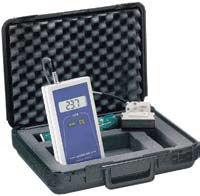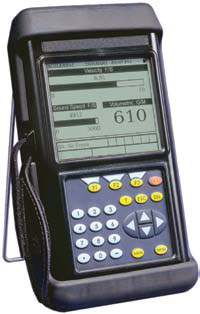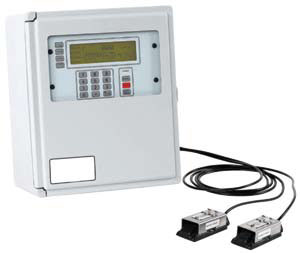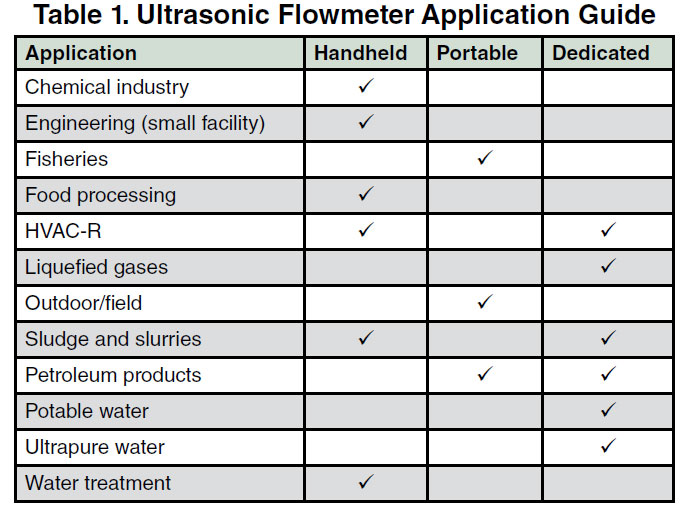In the last decade, ultrasonic flowmeters have grown in popularity in laboratory and process areas as a cost-effective, noninvasive alternative for measuring the velocity and flow rates of liquids and gases. Just as the price of Blu-RayTM disc players has plummeted, the cost of ultrasonic flowmeters has dropped so much that users have been able to replace their older technologies with what were formerly expensive devices.
The payoff they receive is high accuracy and flexibility. With ultrasonic flowmeters, users can choose from various electronics packages, and also use the devices in areas that require explosion-proof devices. These value-added benefits provide a striking contrast to turbine or variable-area flowmeters, which are less accurate, offer fewer output capabilities and are invasive to the process media.
While ultrasonic flowmeters are now cost effective, their most significant benefit may be their ability to measure flow without interfering with any process liquids or gases. The noninvasive measurement is taken from two or more transducers attached to the piping exterior. The frequency shift of an ultrasonic signal that is sent through the fluid or gas is measured, then a signal is sent via cable to the electronics housed in the flow computer.
Other advantages of using ultrasonic flowmeters include:
- Improved accuracies
- No pressure drop
- High turn-down ratio
- No moving parts
- Minimum maintenance
- Long-term cost savings
According to a 2006 Frost and Sullivan report (1), the replacement rate for ultrasonic flowmeters is 12 to 15 years, producing a solid return on investment. This longevity may account for an expanding market for ultrasonic flowmeters when many other flow technologies are shrinking. By 2012, the report projected, the market is expected to grow to an estimated $1 billion in sales.
Ultrasonic Measurement: Doppler and Transit-Time
Two main technologies distinguish ultrasonic measurement:
Doppler technology uses particles or aeration in the fluid as a reflective mechanism to gauge the velocity of the fluid.
Transit-time technology relies on a frequency difference in forward and reverse signals sent through a clean liquid to gauge the fluid's velocity; this fluid must not contain solids or aeration as they will distort the sonic pulses.
Both of these technologies are ideal in creating flow profiles through an existing process when modification of piping or a process line is not possible.
Selecting an Ultrasonic Flowmeter Style
To determine what style of ultrasonic flowmeter will be most effective for any specific application, consider how it will be used. The three primary styles are handheld, portable, and dedicated.
Handheld ultrasonic flowmeters are exactly what they seem to be. They generally include a case for transporting the meter between locations within a factory, process area or facility. While they are priced lower as compared to other ultrasonic flowmeters, their functionality is limited to basic flow rate measurement. Typical accuracies are ±2 percent full-scale or better.
On average, the handheld models are battery powered or rechargeable. Most will have a four- or five-digit display and will show flow in GPM or LPM. The unit is easy to use-simply turn on the flowmeter and hold the transducer (which sends and receives radar signals) to the pipe to take a reading. Most handheld ultrasonic flowmeters use Doppler technology. Some are now capable of datalogging and employ RS-232 output for recordkeeping needs (if required for ISO compliance).

Handheld ultrasonic flowmeter
Handheld flowmeters are most commonly used to measure slurries and dirty fluids in the chemical industry, food processing and water treatment plants where basic flow measurement is occasionally required. Facility engineers working in office buildings or small-scale process plants frequently need to monitor HVAC-R systems. Typically, these engineers will use a handheld unit to accomplish this task.
Portable ultrasonic flowmeters are more advanced than the handheld models and also more expensive. These larger units use both Doppler and transit-time technologies to measure flow and velocity.
Most high-end portable Doppler and transit-time ultrasonic flowmeters employ digital signal processing (DSP), digital cross-correlation and a proprietary time expansion algorithm-producing outstanding accuracy as compared to handheld models. The design of the transducer set enables the flow to be measured in a broad range of pipe sizes and materials. Transducers used with ultrasonic Doppler flowmeters do not operate well with concrete, clay or fiberglass pipes as the transducers do not have the capability to "see" through such dense materials.

Portable ultrasonic flowmeter
Many portable systems are suitable for survey work in remote locations. For example, fisheries need to monitor the input and output of water flow on a daily basis to confirm filtration is at adequate levels. Large petrochemical facilities also measure and monitor flow regularly. These facilities can extend over a wide area, requiring an engineer to employ a portable system if dozens of locations are measured.
A waterproof enclosure can protect the transmitter from accidental immersion or splashes. When wired power is not available, most portable meters will operate from eight to 24 hours on an integrated, rechargeable battery. If operating in a wired installation, a 4 to 20 mA or voltage output can be used for continuous monitoring of flow rate.
Several portable models are available with a datalogger that can be unplugged for data downloading without disrupting the meter's operation. Proprietary software is usually included with these flowmeters. A portable unit can be programmed through its integrated keypad allowing control of operating parameters. Many portables can also be programmed via a PC or laptop.
The displays on portable ultrasonic flowmeters are usually much larger than handheld meters, enabling the user to see more data at a glance. Because the flowmeter cases are NEMA 4X rated or better, these units are suitable for continuous outdoor use. They can also be used in wide temperature range applications. Dynasonics, GE Sensing and Thermo Scientific are some of the manufacturers for portable ultrasonic flowmeters.
Dedicated ultrasonic flowmeters are designed to be installed and operated in one location. They are used almost exclusively in plants and process areas. These flowmeters operate well in HVAC-R, potable water, ultrapure water, petroleum products, sludge and slurries, and liquefied gases applications.

Dedicated ultrasonic flowmeter
As with portable units, dedicated ultrasonic flowmeters use both Doppler and transit-time technologies. Unlike portable units, though, dedicated units deliver unique benefits and options. Many manufacturers (including GE Sensing and Thermo Scientific) offer intrinsically safe and ATEX-rated units for the petrochemical markets. They also have units that are DC or AC powered and operate with digital communications. Dedicated units have electronics housed in enclosures rated NEMA 4X and contain NEMA 6-rated transducers. They are typically waterproof, preventing damage in case of accidental immersion.
Some manufacturers offer 30,000-point datalogging and accuracies to ±0.5 percent full-scale. Easily installed, the transducers clamp on to pipes that range in size from 1 to 200 in. and offer bidirectional flow measurement.

Conclusion
With prices dropping and benefits increasing, users may want to upgrade from older technologies and invest in an ultrasonic flowmeter. Users should choose the best model by assessing the following criteria: ultrasonic measurement technology, application usage and option efficiencies.
Use the Ultrasonic Flowmeter Application Guide (Table 1) to help determine typical applications for each type. Added features and options (such as finer precision, advanced datalogging capabilities, etc.) may tip the balance toward one or two models. Consult a flowmeter manufacturer for more information
Pumps and Systems, July 2010

